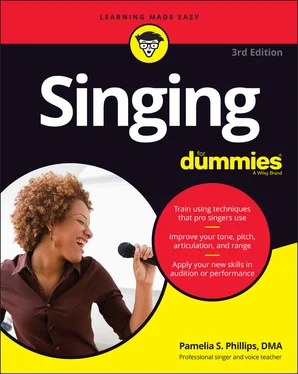Finding your tone: Vocal tone is important because you want the best sounds to come out of your mouth. By exploring exercises on tone, you can make changes to your sound. People often tell me that they want to change the way they sound. To change your sound, you need to know how you create sound. The two chapters on tone, Chapters 5and 6, give you quite a bit of information about how to start a note and then what to do to make the note sound a specific way.
Developing Your Singing Voice
When you have the basic information swimming around in your head, you can start to work on your singing voice. Chapters 6through 9offer you more specific information about how to create a sound that’s unique to you. Sometimes singers try to imitate their favorite famous singer. A better idea is to sound like yourself. Your voice can be just as fabulous as that famous singer’s. You just have to practice to develop it.
Following are some points to work on:
Filling the auditorium with resonance: Resonance is the echoing of tone. In Chapter 7, you find out how to use resonance to project your voice. Singing loudly makes a lot of sound, but using resonance allows you to project the sound over the orchestra to the back of the concert hall. Find out how your voice can resonate so Uncle Sam can hear you from the back row.
Fine-tuning vowels and consonants: A long time ago in grade school, you had to work with vowels and consonants. Well, you can refresh your memory in Chapters 8and 9. By making your vowels and consonants specific, you can make yourself easily understood when you’re singing. You’ve probably heard someone sing but couldn’t understand a word they said. It’s even worse when the song is in a language that you speak. By knowing how to articulate vowels and consonants, you can create specific sounds that your audience can follow.
Warming up your voice: Practice makes perfect! After you discover all this great information about singing, you need to develop a plan for practicing it on a regular basis. If practicing seems like a foreign concept to you, check out Chapter 10. The whole chapter is devoted to helping you figure out what to do when you warm up and how to apply the exercises that you read about in the book to your daily practice routine. Because you can explore so much, make a list of what you want to accomplish today, and then add more to that list each time that you practice.
Working the Different Parts of Your Voice
Your goal is to make your singing voice sound like one smooth line from top to bottom. Your voice may have a few bumps and wiggles as you work your way up and down. That’s perfectly normal, but help is right at hand. Chapters 11and 12work with specific areas of the voice called registers — chest voice, middle voice, and head voice. In these chapters, you can discover what each part of the voice feels like and what to do with it. When you’re ready, try these tips:
Strengthening your middle, chest, and head voice to get a complete vocal workout: The first step in the workout for the voice is to find the different registers of the voice and then notice what each feels like. After you find them, you want to try to smooth the transition between registers. You may find that your chest voice and head voice feel miles apart. The exercises in Chapters 11and 12are designed to help you smooth out the bumps. You may not think the exercises are easy in the beginning, which is good. I don’t want you to be bored. Even if you’ve never explored any vocal sounds, you can figure out these exercises and get your voice in good working order — it just takes some time and patience. Chapter 12helps you refine your register transitions and extend your range. Some songs require flexibility, and the exercises in the chapter help you develop agility and even try out your agility in some pop riffs.
Adding belting technique to your list of skills: Your speaking voice needs a workout to get you started on belting. Belting is the sound that you want to make for musical theater or pop-rock songs. The exercises start from the beginning, so you don’t have to know anything about belting to take on the information in Chapter 13.
After you explore your technique through the exercises that I provide, you need to take the next step. Chapters 14through 18are about applying your technique. At some point, you want to apply that healthy technique to songs. You also want to maintain your healthy technique and a healthy voice at all times. When your technique is really cooking, you can explore Chapters 19and 20, about moving your technique into a performance situation. Performances can be big or small. Whatever the size of the audience, you want to look like a pro and feel good about what you’re doing onstage.
To start applying your technique when singing songs for yourself or others, consider the following:
Training for singing: Finding a voice teacher can be tricky. When you find the right teacher, the experience can be rewarding. If you aren’t sure how to go about finding a teacher, explore the tips and suggestions in Chapter 15. Finding the teacher may be the most difficult part. After you answer the questions in Chapter 15, you’ll have a better idea of what you want from voice lessons. Whether or not you hire a voice teacher, you can check out Chapter 14for information about training to sing different styles of music. Knowing what’s required of your voice allows you to dive right into the right chapters.
Choosing appropriate singing material: Finding new songs to sing can be overwhelming. You have so many choices, but how do you know what works for you? The clues are in Chapter 16. The lists there offer suggestions on what to look for and what to avoid when choosing songs. Whether you want a song to sing for your own pleasure or a song for a specific function, you want a song that accentuates your strengths.For more suggestions of songs, you can explore Appendix Afor a list of suggested songs for enhancing your singing technique. The songs cover different styles of music, from classical to country. After you choose the song you want to sing, check out Chapter 17for some tips on how to conquer the song in a short amount of time.
Feeling comfortable with the music and text: In Chapter 18, you can explore acting to combine with your singing. Sounding good when you sing is great, but you want to sound good and understand the story behind the music. You don’t have to know anything about acting to explore this chapter; it’s all right there for you.
Overcoming performance anxiety: If your daydreams of singing are clouded with anxiety about singing in front of an audience, Chapter 19is just for you. By confronting your fear and taking charge, you can make progress and let go of the anxiety. You only add pressure to your performance if you assume that you’re supposed to be totally calm. Many famous performers get nervous before a performance. After exploring Chapter 19, you’ll know that it’s fine to be nervous, but you can still sing while nervous.
Nailing your audition: So many singers dream of auditioning for a Broadway show or entering a singing competition that I wrote a whole chapter about auditioning your song. Chapter 20has information for you on what to expect at the audition, what you may have to sing or do, and how to prepare for the audition. Because an audition for a musical is different from an audition for an opera, you want to know what’s kosher and what’s not.
Singing is about more than just alignment and technique — although, of course those considerations are important. If you concentrate only on the technical aspect of singing, you may end up singing from your head rather than your heart. Remember to let loose every once in a while and have fun with it!
Читать дальше












